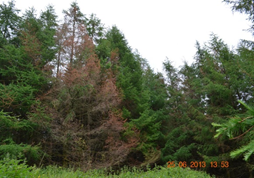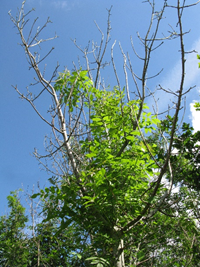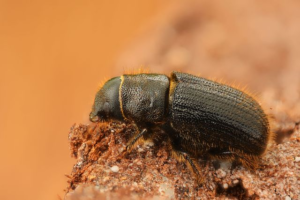What’s the threat? Tree pests and diseases to look out for (FWN 33)
22 October 2019The Tree Health team in Scottish Forestry carries out aerial and ground-based surveillance of woodlands and forests across Scotland.
Their objective is to detect harmful pests and diseases early so that appropriate action can be taken to either eradicate or contain them or slow down their spread and reduce their impact. Some of the main tree health threats we are currently dealing with are outlined here.
Through our bi-annual aerial surveillance programme, we are able to monitor 80-90% of the productive forest area of Scotland, pinpointing symptomatic trees and then sending out trained inspectors to diagnose the cause of those symptoms. Individual trees sometimes need to be felled to ensure nothing is missed. Typically, we are looking for trees showing signs of recent significant stress such as needles or leaves turning orange or brown during the summer months, or atypical resin/sap bleeding on stems and branches. In a busy year, this can involve over a thousand site inspections in sometimes remote locations. Many require no subsequent action as the causes are often things like lightning strike, wind or snow damage, localised flooding or bark stripping by deer or squirrels. Although Scottish Forestry undertakes annual tree health surveillance work this does not – and cannot – relieve landowners and forest managers of their primary responsibility to monitor their own woodlands and forests. It is required by law that diseases classified as notifiable are reported.
Great spruce bark beetle – notifiable disease; Spruces and Pines
Two of the commonest conifer species in Scotland are the Norway spruce and Sitka spruce. They are often planted as shelterbelts in agricultural landscapes as well as in multi-purpose forests. Between them, they make up almost 50% of Scotland’s forestry resource. The great spruce bark beetle (Dendroctonus micans) is not native to the UK and has the potential to be a significant pest of spruce trees in Scotland. Years of research and ongoing proactive monitoring and mitigation action are successfully managing that threat.
Through the warmer summer months, the female beetles emerge, seeking a suitable spot under the bark of a spruce tree to lay hundreds of already fertilised eggs. Depending on the availability of a suitable host tree and weather conditions, that may just require a short walk up or down the tree they have just emerged from, or a flight to search for a new tree. With a favourable wind, females can travel several kilometres in search of a suitable tree but most dispersal takes place much closer to home. The sticky sap of spruces will generally form an effective defence against many types of bark beetle attack, but D. micans is one of the few that can overcome the defences of even a healthy tree. Trees under stress from drought, flooding or other factors cannot produce as much sap so are at greater risk of attack.
The sticky sap of spruces will generally form an effective defence against many types of bark beetle attack, but D. micans is one of the few that can overcome the defences of even a healthy tree. Trees under stress from drought, flooding or other factors cannot produce as much sap so are at greater risk of attack.
The female beetle attempts to burrow under the bark of a spruce tree and, if she successfully overcomes the tree’s defences, she will lay up to 300 eggs in batches of 50- 80. After hatching, the larvae feed on the inner woody layers of the bark for a year or two. Each brood is capable of eating through a patch of bark up to a foot wide. Three or four broods can destroy the inner bark right around a tree, ringbarking and killing it.
However, there is a natural method to combat the bark beetle, recently featured on the BBC’s Countryfile. Thanks to pioneering work undertaken when D. micans was first detected in Wales and the Welsh Marches in the 1980s, Forest Research (with funding from Scottish Forestry, the Forestry Commission in England, and Confor) now breed a host-specific predator beetle (Rhizophagus grandis) that can effectively control populations of the bark beetle in most situations. Surveys carried out by Scottish Forestry, and reports from forest managers, allow us to locate infested trees and release the predator beetle to limit the damage.
The predator beetle’s larvae will eat enough bark beetle larvae to greatly reduce their impact. As the predator beetle will only lay eggs when it finds populations of the great spruce bark beetle it does not pose a threat to other native insects. Releases of the predator beetle are done at no direct cost to the landowner, all we ask for is access to sites for our surveyors – the predator beetle will do the rest!
Green spruce aphid; Spruces
The green spruce aphid (Elatobium abietinum) is present across Scotland and in most years is barely noticed. However, in peak years, such as this one, it can cause very noticeable needle loss, particularly on Sitka spruce. Edge trees in small shelterbelts are particularly vulnerable to damage. Spruces typically keep needles for 3-5 years, growing a new set on the outermost twigs each year. The aphid normally feeds on the oldest needles but when the populations are very high it can attack the current year’s needles. At worst, this can leave only a tuft of fresh needles on the very tips of the twigs. Infected trees may look very brown and ‘sparse’ from midsummer onwards.
This year’s aphid populations are now ‘crashing’ due to a lack of food, and predator species feeding on the bountiful aphids. Affected trees, although stressed and not growing as much as in normal years, should survive and return to a healthy cover of needles in the coming years. As there are currently no feasible biological or chemical control treatments in a forest context. Management of this pest may require changes in silvicultural practices – currently the focus of research.
Ramorum, Larch disease – notifiable disease; Larches, Rhododendron, Shrub Species
Phytophthora ramorum, often referred to as ‘Ramorum’, is a highly infectious and normally fatal water mould which has been affecting larch trees in Scotland since 2010, particularly in wetter western areas. Although it will also infect a wide variety of other trees and shrubs, it is particularly damaging on larch due to the high levels of infectious spores produced on infected needles. These spores are able to travel in droplets of water in rain and mist, sometimes over large distances. Infection spreads rapidly in the inner  bark, the tree quickly becomes unable to transport water and nutrients from the roots to the crown, and death can happen within just a few months.
bark, the tree quickly becomes unable to transport water and nutrients from the roots to the crown, and death can happen within just a few months.
In some years, levels of infection can be very high, sometimes causing most of the larch trees in a forest to die over the course of a single summer. This was very evident in 2014 when extensive death was observed over thousands of hectares of larch in south-west Scotland.
Typically, infections only become apparent when the needles of an affected branch or tree begin to turn orange or brown in early summer. Once an infection is confirmed, a statutory plant health notice (SPHN) is issued by Scottish Forestry requiring the landowner to fell a defined area of larch to attempt to contain the infection. Felling is currently the only feasible way to slow down the spread and impact of the disease.
Grants are available from Scottish Forestry to manage felling and assist with replanting the site with suitable, alternative tree species. The timber of infected larch trees can still be utilised (albeit with some biosecurity restrictions on the transport and processing of the timber), which helps to pay for the felling operations. Current research is attempting to find larch trees with a tolerance of Ramorum.
Chalara ash dieback – notifiable disease if found in new areas; Ash
Ash trees in much of the country are being increasingly affected by dieback caused by the fungus Hymenoscyphus fraxineus (commonly known as ‘Chalara’ due to its previous Latin name). In Scotland, it was first found on newly planted trees west of Glasgow in 2012 but subsequently found to be widely distributed elsewhere. The disease typically results in branch dieback, often with subsequent death of trees when secondary fungal diseases gain a hold on the already stressed and weakened tree. During that process, which can happen rapidly in younger trees but may take a number of years with older trees, branch shedding and tree instability will present an increasing safety risk. Landowners and managers must closely monitor trees close to roads, railways, buildings, or areas with significant public access and take appropriate action.
The wind-borne spores of the disease can travel many miles, making it difficult to stop the spread. Live trees should only be felled if they present a safety risk. We are looking out for native ash trees with some resistance – those which remain healthy or do not appear to be as heavily affected as those around them. Trials are already underway to assess a range of UK native ash trees, although current evidence from the UK and mainland Europe suggest that only 1-5% of our main ash species (Fraxinus excelsior) is likely to exhibit resistance.
Reporting suspected pests and diseases:
If you are concerned about the health of any trees, seek professional advice. It is required by law that diseases classified as notifiable are reported.
Observatree
Forest Research
Scottish Forestry
UK Government biosecurity guidance
Paddy Robertson, Tree Health Planning & Contingency Manager at Scottish Forestry, for the Farm Advisory Service.
This article is taken from the Autumn 2019 edition of the Farm Woodland News. You can download the entire edition and sign up to ensure you receive the latest copy as it is published by using this link.
Sign up to the FAS newsletter
Receive updates on news, events and publications from Scotland’s Farm Advisory Service


